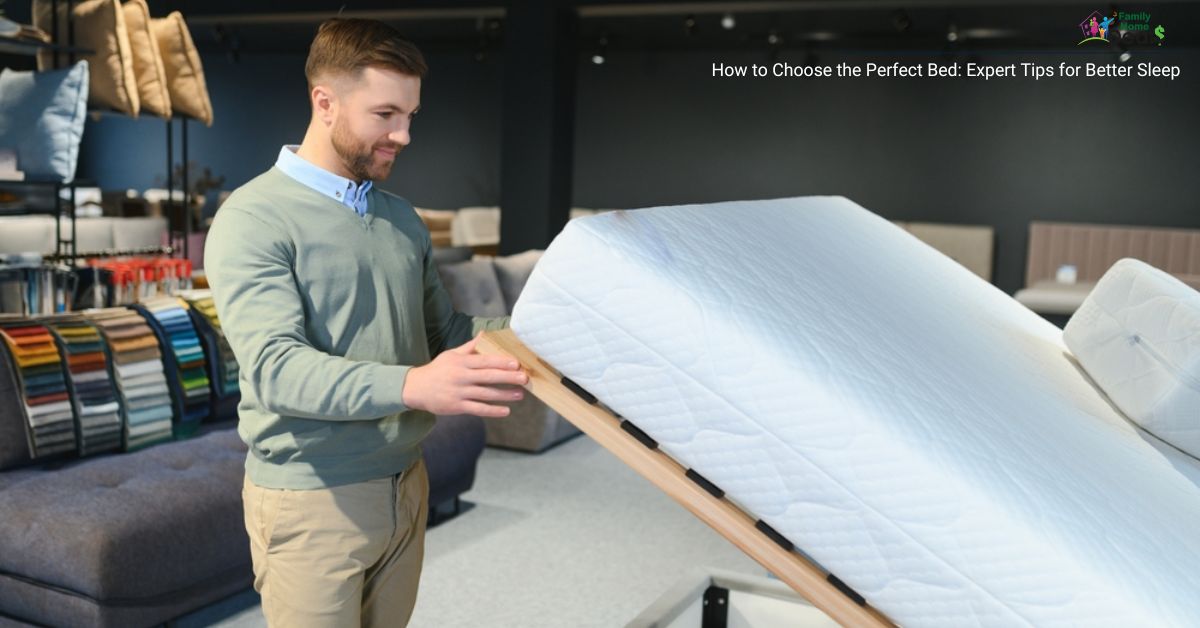
Finding the right bed isn’t just about picking a mattress that looks comfortable—it’s about choosing one that supports your body, suits your lifestyle, and helps you wake up feeling fully refreshed. But with so many materials, sizes, features, and price points available today, it’s easy to feel overwhelmed. The good news? Once you understand the key factors that actually matter, choosing the right bed becomes a lot simpler.
Whether you’re upgrading your old mattress, furnishing a new home, or trying to fix years of restless nights, this in-depth guide breaks down everything you should consider. From comfort and support to budget and sleep habits, here’s how to confidently pick the perfect mattress that promises long-lasting comfort and healthier, more restorative sleep.
Why Your Bed Choice Matters More Than You Think
Your sleep quality impacts nearly every aspect of your well-being—from mood and memory to immunity, metabolism, and long-term health. Studies consistently show that sleeping on a supportive and comfortable mattress can significantly improve sleep quality and reduce pain. According to the Sleep Foundation, a mattress that properly supports spinal alignment can ease pressure points and help reduce discomfort across the shoulders, hips, and back.
When you invest in the right bed, you’re not just buying furniture—you’re creating the ideal environment for your body to recharge every night. Let’s explore the most important factors to consider before making your next purchase.
1. Comfort: Finding the Feel That’s Just Right for You
Comfort is the heart of mattress shopping, but it’s also the most personal factor. What feels heavenly to one person may feel terrible to someone else. That’s why taking time to test different beds is essential.

What Makes a Mattress Comfortable?
Comfort isn’t just about softness. It comes from a combination of:
-
Firmness level
-
Material type
-
Temperature regulation
-
Pressure relief
-
Body weight and sleep position
Firmness Preferences
-
Soft (Plush): Great for lightweight sleepers and side sleepers.
-
Medium: Works well for most sleepers, especially combination sleepers.
-
Firm: Ideal for stomach sleepers and people who need extra support.
Why Material Matters
Different materials produce different sleeping experiences:
-
Memory foam: Contouring, pressure-relieving, but can trap heat unless infused with cooling tech.
-
Latex: Naturally bouncy, breathable, and durable—perfect if you dislike the “hugging” feel of foam.
-
Innerspring: Offers strong support and airflow, but may feel too firm for some.
-
Hybrid: Combines foam and coils for balanced comfort and support.
Stay Cool All Night
If you tend to overheat, look for:
-
Gel-infused memory foam
-
Open-cell foam
-
Breathable latex
-
Hybrid mattresses with coils for airflow
-
Phase-change cooling fabrics
Modern mattresses now often include smart cooling covers or ventilated layers to reduce heat retention—helpful upgrades for hot sleepers.
Pro Tip:
If you buy online, choose brands that offer long at-home trials (often 90–365 days). This allows you to test comfort in real-life sleeping conditions rather than a five-minute lie-down in a store.
2. Support: Keeping Your Spine Properly Aligned
Support refers to your mattress’s ability to maintain spinal alignment while you sleep. A supportive bed keeps your spine in a neutral, natural curve, preventing strain on your neck, back, hips, and shoulders.

What Happens Without Proper Support?
-
Morning stiffness
-
Back or neck pain
-
Hip and shoulder discomfort
-
Restlessness or frequent waking
How Different Mattresses Provide Support
-
Innerspring: Uses coils to create strong support and minimal sagging.
-
Hybrid: Coil foundation + foam layers for balanced comfort/support.
-
Memory foam: Conforms to your shape; ideal for pressure relief.
-
Latex: Naturally supportive and bouncy, great for spinal alignment.
A medium-firm mattress tends to be the best match for most sleepers, according to multiple sleep studies.
If You Have Health Issues
-
Sciatica: Try a medium-firm mattress that reduces lower back pressure.
-
Arthritis: Look for contouring foams or latex to cushion joints.
-
Chronic back pain: Consider hybrid mattresses designed for lumbar support.
-
GERD or breathing issues: Adjustable bases can elevate the upper body for relief.
Support Checklist
Your mattress should allow:
-
Neutral spine alignment
-
Even weight distribution
-
No sagging
-
No pressure on joints
If you wake up feeling sore or strained, your bed may be lacking support—even if it feels soft or comfortable at first.
3. Durability: Ensuring Your Bed Stands the Test of Time
A mattress is a long-term investment, and durability determines how long it will maintain comfort and support.

Typical Lifespans
-
Innerspring: 5–8 years
-
Memory foam: 7–10 years
-
Hybrid: 7–10 years
-
Latex: 10–15+ years (most durable option)
What Affects Durability?
-
Material quality
-
Foam density
-
Coil count and thickness
-
Maintenance habits
Foam Density Guide
-
High-density foam: Most durable, ideal for long-term support.
-
Medium-density foam: Balanced comfort and longevity.
-
Low-density foam: Affordable but less durable.
Coil Quality Indicators
Look for:
-
Thicker gauge coils (12–14 gauge)
-
Individually pocketed springs
-
High coil counts are appropriate for the mattress size
How to Extend Your Mattress’s Life
-
Use a mattress protector to guard against spills and dust mites.
-
Rotate your mattress every 3–6 months (unless your brand advises otherwise).
-
Ensure proper foundation or frame support.
-
Avoid consistently sitting on the edge.
Considering the average person spends roughly 26 years of their life sleeping (Sleep Foundation), keeping your mattress in top shape is absolutely worth the effort.
4. Budget: Balancing Quality and Affordability
Mattress prices vary widely, but you don’t need to overspend to find a great one. It’s all about understanding what features genuinely matter to you.
General Price Ranges (2025 Market Overview)
-
Innerspring: $300–$1,500
-
Memory foam: $400–$2,000
-
Hybrid: $800–$2,500
-
Latex: $1,000–$3,500
When Should You Spend More?
Consider investing in:
-
Premium cooling if you sleep hot
-
Organic or natural materials
-
High-density foam or high-quality latex
-
Enhanced edge support for couples
-
Adjustable bases for targeted comfort
Money-Saving Tips
-
Shop during major holiday sales (Memorial Day, Black Friday, Labor Day).
-
Compare trial periods and warranties to get better long-term value.
-
Check for bundle deals (pillows, frames, or protectors included).
A mattress is something you use every single day—it’s worth choosing one that supports your comfort and health for years.
From Rover to Relaxation Mode: The Must-Have Pet Bed and Cover Combo
Does your sofa secretly double as your dog’s personal lounge? Then you’ll love how FunnyFuzzy turns that chaos into chic comfort—sleek furniture covers and plush pet beds that match your décor and survive the tail wags. Whether your cat is bossing the cushions or your dog is flattening the throw pillows, this is where style meets paw-approved durability. Upgrade your living room (and your pet’s chill zone) in one click by visiting funnyfuzzy.com today.
5. Size: Matching Your Bed to Your Space and Lifestyle
Choosing the right mattress size impacts not just your comfort, but also your room layout and daily life.
Common U.S. Mattress Sizes
| Size | Dimensions | Ideal For |
|---|---|---|
| Twin | 38″ x 75″ | Kids, teens, small rooms |
| Twin XL | 38″ x 80″ | Taller teens, dorms, adjustable bases |
| Full | 54″ x 75″ | Solo sleepers, guest rooms |
| Queen | 60″ x 80″ | Couples, most bedrooms |
| King | 76″ x 80″ | Couples + kids/pets |
| California King | 72″ x 84″ | Tall sleepers, long rooms |
How to Choose the Right Size
Ask yourself:
-
Do you share the bed?
-
Do pets or children join you?
-
How much space do you prefer to move around?
-
Will your room layout accommodate the size comfortably?
Measure your room before deciding—your mattress should fit with room to walk, place furniture, and open doors comfortably.
6. Sleep Position: Choosing the Best Mattress for Your Sleeping Style
Your sleep position affects how your mattress should support your body.

Side Sleepers
-
Need pressure relief for hips and shoulders
-
Best with: Medium-soft to medium mattresses
-
Materials: Memory foam, latex, hybrid
Back Sleepers
-
Require balanced support and contouring
-
Best with: Medium-firm mattresses
-
Materials: Hybrid, latex, high-density memory foam
Stomach Sleepers
-
Need firm support to prevent spine bowing
-
Best with: Firm mattresses
-
Materials: Firm innerspring, firm hybrid
Combination Sleepers
-
Switch positions during the night
-
Best with: Medium-firm hybrid for flexibility
If you’re not sure which category you belong to, think about the position you fall asleep in—and the one you wake up in most often.
How to Choose the Perfect Bed for Better Sleep
Finding the perfect bed is about understanding your body, preferences, and lifestyle—not just picking the trendiest mattress. When you consider key factors like comfort, support, durability, budget, size, and sleep position, you dramatically increase your chances of finding a bed that helps you sleep deeper, feel better, and wake up pain-free.
A well-chosen mattress doesn’t just improve your nights—it transforms your days. Better sleep means better focus, mood, and overall well-being. So take your time, test out options when possible, and choose the mattress that genuinely supports the way you live and sleep.
By paying attention to what truly matters and investing wisely, you’re setting yourself up for years of restful, restorative sleep—something everyone deserves.



